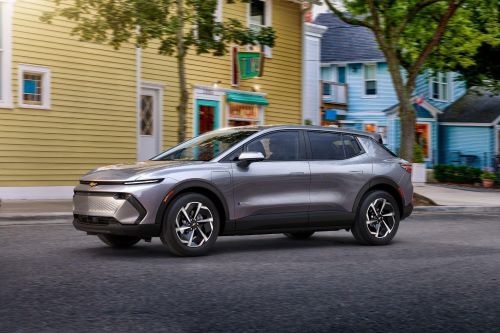Marking a significant stride
General Motors (GM) has adeptly navigated the electric vehicle (EV) landscape with the introduction of the Chevrolet Equinox EV, marking a significant stride in making electric mobility accessible to a broader audience.
This move is underscored by GM’s keen pricing strategy and the utilization of advanced manufacturing techniques, which collectively bolster the Equinox EV’s position as a practical and affordable option in the competitive EV market.
Synergizing Policy and Strategy for Affordable Electrification
The affordability of the Chevrolet Equinox EV is further accentuated by its eligibility for the U.S. federal EV tax credit, offering up to $7,500 in savings. This incentive is not merely a financial boon for potential buyers; it also reflects the synergy between government policy and corporate strategy in accelerating the adoption of electric vehicles.
By aligning the Equinox EV’s market entry with such incentives, GM not only lowers the entry barrier for consumers but also leverages policy support to enhance the vehicle’s market attractiveness. If you want to know more about the brand, one of Chevrolet’s models was featured in QW’s overview of electric truck towing capacities.
Affordable EVs through Pricing and Policy
The strategic pricing and potential tax savings are integral components of GM’s overarching strategy to expand electric vehicle adoption across various market segments. This approach serves a dual purpose: it not only underscores the critical role of supportive government policies in promoting EV adoption but also positions the Equinox EV as an enticing proposition for consumers contemplating the transition to electric mobility.
The move signals GM’s commitment to not just participate in the EV market but to lead it by making electric vehicles more accessible and appealing to a wider audience.
Dive into the best EV lease deals to uncover the most advantageous Chevrolet’s leasing opportunities available in March 2024.
Strategic Manufacturing Meets Ultium Innovation
Moreover, the manufacturing of the Chevrolet Equinox EV in Ramos Arizpe, Mexico, utilizing GM’s state-of-the-art Ultium battery and chassis technology, plays a crucial role in its eligibility for tax credits.
This strategic choice of manufacturing location and technology adherence not only meets the U.S. government’s requirements for tax incentives but also reflects GM’s global manufacturing strategy designed to enhance the competitiveness of its EV offerings. The Ultium platform represents the pinnacle of GM’s innovation in electric vehicle technology, offering enhanced performance, efficiency, and adaptability.
By incorporating this technology into the Equinox EV, GM not only adheres to regulatory requirements but also provides consumers with a vehicle that is both technologically advanced and environmentally friendly.
Bridging Design, Tech, and Accessibility
The Chevrolet Equinox EV’s appeal extends beyond its financial incentives and technological advancements. Its design, performance features, and utility are crafted to meet the diverse needs and preferences of the modern consumer.
The vehicle’s competitive pricing, coupled with the potential for significant tax savings, positions it as a compelling entry point for individuals and families looking to embrace electric mobility. This strategic positioning is indicative of GM’s broader vision to lead the transition towards a more sustainable automotive future by making EVs more accessible to the masses.
GM’s Strategy for a Greener Future
In essence, the introduction of the Chevrolet Equinox EV by General Motors is a testament to the company’s strategic foresight in the evolving automotive landscape. Through competitive pricing, advanced manufacturing technologies, and the leveraging of governmental incentives, GM has not only enhanced the Equinox EV’s market appeal but also underscored its commitment to sustainable mobility.
As the automotive industry continues to pivot towards electrification, GM’s approach with the Chevrolet Equinox EV exemplifies how strategic alignment between product offering, technological innovation, and policy support can successfully drive the adoption of electric vehicles, making a greener future more attainable for all.
Chevy: A Century of Innovation and American Automotive Culture
Chevrolet, commonly known as Chevy, has been a cornerstone of the automotive industry since its inception on November 3, 1911. Founded by the Swiss race car driver Louis Chevrolet and ousted General Motors founder William C. Durant, Chevrolet’s mission was to produce vehicles that exemplified performance, style, and value. This partnership between a visionary entrepreneur and a skilled mechanic and racer led to the creation of a brand that would become synonymous with American automotive culture.
Chevrolet made an indelible mark on the industry with the introduction of the Chevrolet “Classic Six” Series C in 1912, a model that promised a blend of spaciousness and power. However, it was the launch of the Chevrolet Series 490 in 1915, aimed to rival Ford’s Model T, that truly solidified Chevrolet’s place in the market. This vehicle’s competitive pricing and superior driving experience propelled Chevrolet into the spotlight, allowing Durant to leverage its success to regain control over General Motors. Under GM’s umbrella, Chevrolet was positioned as the volume leader, tasked with producing vehicles that offered reliability and value across diverse consumer segments.
The subsequent decades saw Chevrolet introducing a series of innovations and iconic models that would define generations. The 1929 Chevrolet International Series AC introduced the six-cylinder engine, marking a new era of power and efficiency. The post-World War II era ushered in the small-block V8 engine in 1955, an engineering marvel that remains influential to this day. The 1950s and 1960s were golden years for Chevrolet, highlighted by the launch of the Corvette in 1953, America’s first sports car, and the immensely popular Impala in 1958.
Facing the challenges of the oil crisis and increased foreign competition in the 1970s and 1980s, Chevrolet pivoted towards innovation in fuel efficiency and safety, while also catering to the performance segment with models like the Camaro. The brand’s adaptability was further demonstrated in the 21st century with the introduction of the Volt, a pioneering mass-produced plug-in hybrid, underscoring Chevy’s commitment to environmental sustainability and technological advancement.

